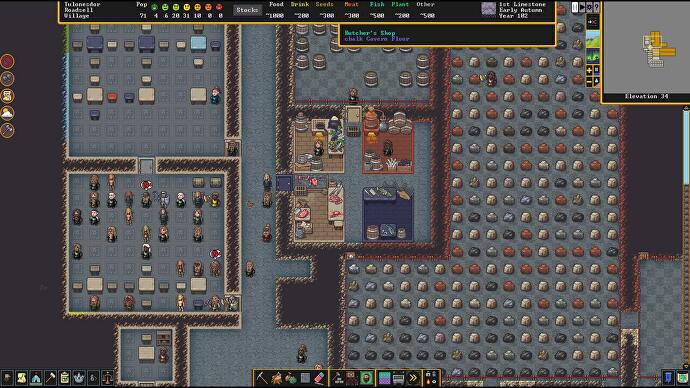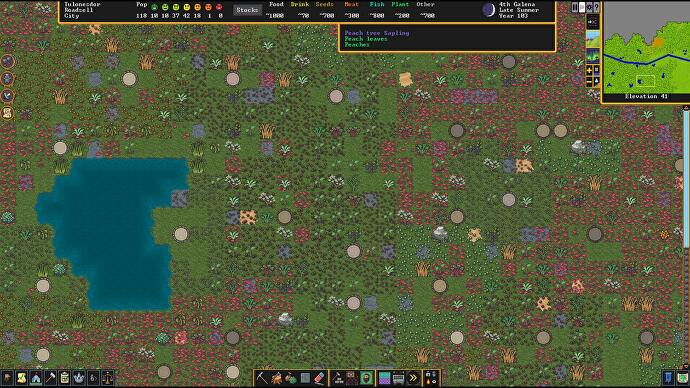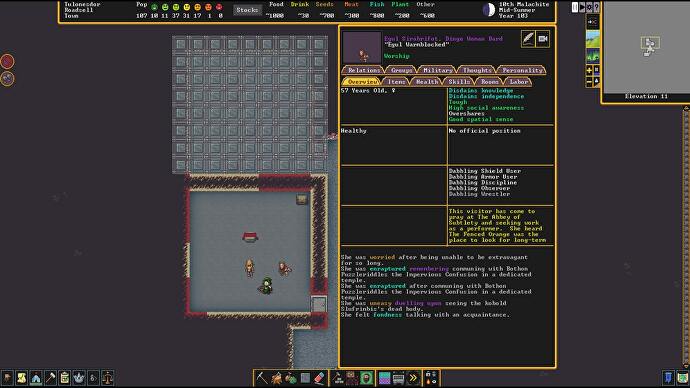Dwarf Fortress review: the legendary colony sim gets a welcome facelift for Steam

How the heck do you review Dwarf Fortress? Much like the procedurally generated world spat out at the start of every game, there’s already a huge pile of established lore and history out there from the 16 years it’s been around. It’s like being asked to review Lord of the Rings. It’s a vast undertaking, and there aren’t any friendly eagles on hand to cut through its dense myth. Prior to releasing on Steam, I had put a few dozen hours into what is now known as Dwarf Fortress Classic (which is still available for free from Bay 12’s website), split over several different periods of time. Thing is, I never really got very far. I’d find a good tutorial, lose a few fortresses to horrible mistakes and then really get established. But then I’d be distracted by the realities of everyday life and by the time I got back to it, I’d forgotten everything and all my resources were hopelessly out of date because of all the wonderful, lovingly detailed updates. Then the cycle would start again.
The good news is that this new version of Dwarf Fortress released on Steam does an admirable job of making the game considerably more approachable. I was apprehensive at first, but then something clicked and I lost the first of what would be many afternoons over the past fortnight, safe in the knowledge that when I eventually stepped away from this goliath, I’d be able to come back without feeling overwhelmed and have to start all over again. It’s still good ol’ Dwarf Fortress, but this is the most accessible the game has ever been while still being deep, demanding and a legend worthy of being inscribed on a mudstone goblet.
Here are the basics. Dwarf Fortress is a colony sim where you take a group of seven dwarven colonists and aim to build, well, a fortress. While you may start with a hastily dug hole for shelter, something akin to everyone’s first Minecraft house, your ultimate goal is a sprawling city that’s a mere fortress in the same way that Moria is just a mine. Along the way, you must take care of your colonist’s needs, tell them where to dig and help them interact with nearby settlements both friendly and otherwise.
It’s a straightforward concept, but Dwarf Fortress has two things that set it apart from its forebears as well as the games it inspired. First is the absolutely staggering level of detail. From the aforementioned world generation to the individual organs in a dwarf’s body, everything is simulated with ridiculous fidelity. There are wheels within wheels that mesh with mind-boggling intricacy, generating memorable moments galore. Previously, though, that was largely hidden away by its imposing, arcane interface, with its world rendered in minimalist ASCII graphics and its layers of nested menus and countless convoluted keyboard shortcuts requiring several wikis in order to penetrate. This level of detail often felt like Dwarf Fortress had a hostile resistance to actually being played, and it’s this sense of friction that’s defined my relationship with the game in the past.
Thankfully, this new Steam release of Dwarf Fortress is far more approachable. The charming pixel dwarves and chums, as well as the caverns they inhabit, are much easier to parse at first glance, with only a simple mouseover required to tell you exactly what you’re looking at. Combined with a proper point and click interface and menus you can browse through at your leisure, that first barrier to entry is thoroughly smashed.
“The charming pixel dwarves and chums, as well as the caverns they inhabit, are much easier to parse at first glance, with only a simple mouseover required to tell you exactly what you’re looking at”
No longer having to decipher abstract code like you’re looking at the Matrix makes the early stages of the game something that you can just throw yourself into. Your dwarves are going to need food, beds, places to meet and work. It can still be a bit fiddly at times, but its improved tutorials go a long way to easing you in gently. You can figure out that a dwarf needs a bed, and building one and digging a room to put it in is a cinch. There’s still room for improvement, admittedly (how to actually designate and assign bedrooms isn’t nearly so obvious), but it’s a very welcome step in the right direction.
Making the game so much more accessible also reveals what an odd beast it is. Without the struggle of figuring out how to accomplish the most basic tasks, it turns out that survival in Dwarf Fortress isn’t particularly difficult. The game makes a big deal about making it through your first winter, but short of digging into a river and flooding your whole fortress or something (which I have never done, honestly,), doing so is a breeze.

This is Dwarf Fortress at its weakest, especially compared to RimWorld, which I couldn’t help but draw comparisons to. While the latter’s AI storytellers feed you a steady flow of events to react to, you need to be proactive to get the most from Dwarf Fortress. The wonderful details generated by the engine whirring away under the hood, such as the descriptions of engravings or the complex thoughts and needs of each dwarf, aren’t readily apparent, and you need to take the time to delve into the game’s menus to find and appreciate them.
Likewise, the systems that have the most potential to create tales of hilarious disasters, like building elaborate traps or water and lava powered forges, require the player to find and engage with them. They’re not necessary by any means, so if you don’t actively seek them out, you won’t experience their joys.
“While the latter’s AI storytellers feed you a steady flow of events to react to, you need to be proactive to get the most from Dwarf Fortress.”
It doesn’t help that this is where the game’s complexity and frequent obtuseness really hits you, even now. While the tutorial covers the basics and there are some in-game help files that provide a little more detail, it can still be really tricky to figure out how to accomplish a lot of tasks. This is going to be the make or break moment for most players, I feel. It won’t be long before you come across something that you don’t know how to do and, despite clicking through all the menus and help text, you’re stumped. Once again, your only option is to fire up your search engine of choice and consult its extensive network of wikis – and the speed and rate at which you’ll find yourself diving into them is almost certainly going to be off putting for the majority of Dwarf Fortress newcomers.

I’ll be honest, if I was playing the game afresh, this is probably where I’d have given up as well. And that’s fair enough. Dwarf Fortress isn’t going to be everyone’s goblet of tea. But if you can push through its enduring reliance on wikis and fan-made tool tips, it’s here where the game really gets going. During one of my runs, for example, I was suddenly hit by several waves of migration. I went from around 30 residents to over 100 in no time at all. Everything I had built, from bedrooms to kitchens to storerooms, was suddenly rendered deeply inadequate and I was rushing around trying to manage the influx of settlers.
It was brilliant.
I suddenly had demands placed upon me. Dwarves wanted temples and guildhalls. I was asked to select a baron, who immediately required a fancier bedroom and his own tomb, and started mandating the construction of certain goods. It hit me that this was what I was supposed to have spent my first 12 hours preparing for, instead of scrambling to build ten things at once. Of course, I’d know better next time, and thanks to this new Steam release, I know there will definitely be a next time now. Despite the humble origins of your settlement, Dwarf Fortress is really a game about managing a bustling subterranean metropolis with hundreds of residents. Survival is easy; the challenge is in achieving prosperity. I’m still a long way from getting there, but I’m excited to try. I’m still spending half my time reading the wiki, but it’s because I want to learn all the ins and outs of the game’s systems, not because I don’t know how to get something as simple as sand anymore.
Dwarf Fortress is a long-term investment. Playing it is a skill that you need to hone, it requires research and planning. It’s almost a hobby in itself, demanding time and effort. Even in this much more approachable form, it still isn’t a game for everyone, but for a particular flavor of colony simmer, it’s catnip. It’s massive and messy and beautiful, and now I can put it down while I’m hyper-fixating on Star Wars or the next big Marvel drop, and not have to worry about starting over from scratch again when I come back to it later.
Reference-www.rockpapershotgun.com